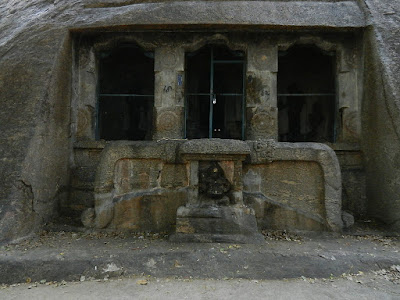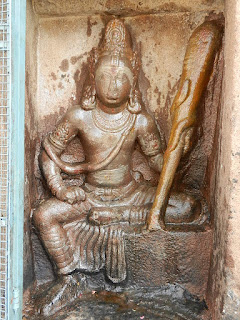The Pandyan dynasty ruled from Madurai, for nearly two thousand years, in some form or another.
In the Sangam age, they had contacts with the
Romans and the Greeks, as seen by coins of Claudius, Domitian, Nero, Vespasian,
Tiberius and Hadrian. Tamil kings issued coins in the Roman style. Tamil
literature notes that Roman artisans built palaces for kings and shaped their
chariots. But little of the art of the Sangam age survives. An inscription in
Poolankurichi talks of temples in the 3rd century but none such have
been discovered yet. Only a few Jaina inscriptions are found in some caves
around Madurai from this period.
After the Sangam age, followed the Kalabhra period
of which little is known. The first Pandyan empire, starting in the middle of
the sixth century with the downfall of the Kalabhras. There were frequent
skirmishes between Pandyas and Pallavas. The era of excavated cave temples
began then, with Pandyas commissioning about 65, far more than the Pallavas.
The Pillaiyarpatti temple near Karaikkudi has a
vattezhuththu inscription of 6th or 7th century. In plan
and caliber of sculptures, these differ clearly from Pallava. In fact they
possibly show some Chalukya influence.
 |
| Tamil Inscription, Malayadikurichi, Tamilnadu |
Next comes Malaiyadikurichi, commissioned by
Sevrukilaan Saatthan, in the 17th year of Maaran Chataiyan, around
647 AD. The bhakthi movement happened around then and the Alvars Nammalvar,
Madhura Kavi, Periyaalvaar and Andal lived in the Pandya country. Saivite saint
Gnana Sambandar converted Pandya king Arikesari Maravarma from Jainism to
Saivism.
Thirupparankunram, excavated by Sattan Ganapati, a
commander under the Pandya Varaguna I, is dedicated to Siva and Vishnu, with
their sanctums facing each other. There is a sculpture of Siva dancing in
Chatura pose. To the left are Sapta Matras dancing, a unique composition.
 |
| Lingodhbhava - Tirumeyyam Satyagiri temple |
Thirumeyyam in Pudukottai district has a Siva
temple of Satyagiri with an enchanting Lingodbhava, with the pillar depicted
from floor to ceiling. The more famous Satyamurthy temple of Vishnu as
Anathashayee, is a riot of characters, the grandest such sculpture in India and
one of the finest in Indian art.
 |
| Anantashayana - Tirumeyyam Satyamoorthy temple Photo: Siddharth Chandrasekar |
The Anaimalai hill of Madurai, which looks like an
elephant, has four groups of monuments : Jain beds on top of the hill, Jain
sculptures at mid-level, and cave temples of Narasimha and Murugan. The Narasimha
temple is excavated in AD 770 by a Pandya commander of Maran Cadaiyan. This
commander died halfway during the construction, and his brother, appointed as
his successor completed the work.
 |
| Murugan and Devasena, in Laadan kovil sanctum |
 |
| Laadan kovil, Anaimalai |
 |
| Jain sculptures, Anaimalai |
 |
| Painted tirthankara, Anamalai Jain caves |
 |
| Tirthankara with Ambika yakshi, Anamalai Jain caves |
The Laadan temple of Muruga, has a Brahmin ascetic
and possibly a Pandya king, besides the majestic two armed Subrahmanya and his
consorts. An inscription says, this was cave temple was the creation of
Parivrajaaka, of Vattakurichi.
The Jain Tirthankaras and yakshis on the mid-level,
carved on an boulder hanging over a natural cavern. Mahavira, Parshvanatha,
Baahubali and Ambika Yakshi are featured. Traces of the original paint on these
sculptures can still be seen.
The Anaimalai hill is a fine example of religious
harmony with Vishnu, Subrahmanya and Jain monuments at very short distance from
each other.
Aritappati also has a rock-cut Linga, from the
mother rock, with a Candesa and Ganesha flanking it outside. In-situ lingas and
a fondness for depicting Ganesha are the Pandya idiom.
 |
| In-situ Linga from mother rock Aritapatti, Madurai |
 |
| Candesha Aritapatti, Madurai |
 |
| Aritapatti cave temple, near Madurai |
The pinnacle of early Pandyan art can be seen in Kalugumalai. Like Mamallapuram, it is incomplete. It a rare monolith, carved from top down, in two finished tiers, after excavating a portion from the slope of the hill, leaving space for the temple in the middle. Its remoteness ensures its anonymity.
It has a full complement of figures: dancing gaNas,
directional deities, apsaras, gods and animals. The sculpture rivals mature
Pallava art. The ganas jump and dance with exuberance. All profiles are done in
excellent proportion, and the sculptors conspicuously demonstrate this mastery.
Saying, “The Kalugumalai artists, could make their ganas leap out of their
architectural rigidity and jump through space,” Nagaswamy exhibits his
virtuosity in creating new English idiom too!
 |
| Mridanga Dakshinamurth, Kaluguamlai |
 |
| Playful ganas, Kalugumalai |
 |
| Subrahmanya, Kalugumalai |
 |
| Vishnu, and gaNas, Kalugumalai |
 |
| gaNas with ghatams |
 |
| ganas blowing conches (shankha) |
 |
| UmaMaheshvara, Kalugumalai |
The supreme talent and creative diversity of the
artist is reserved for the Supreme deities: Siva as UmaMaheshvara, with Parvati
passionately turned towards him. “For one desirous of experiencing an
overflowing aesthetic joy,” says SaHridaya Nagaswamy, the supreme elegance of Dakshinamurthy
is the sculpture to be seen.
 |
| Jain tirthankaras, Kalugumalai |
 |
| Ambika Yakshi, Kalugumalai |
We also see artistic excellence of the large
repertoire of Jain sculptures, especially in Ambika and the Parsva devatas :
such depictions are not seen even in the Pallava region.
Sculptures of the Rajakkalmangalam temple also
exhibit a uniquely Pandyan idiom and beauty. This temple no longer exists, but
its sculptures are in Tirumalai Nayak Mahal museum in Madurai. With the
conquest of Pandyas by the Cholas, the idiom of the latter then took over.
 |
| Rajakkamangalam Narasimha Photo: Kallidai Ram |
 |
| Rajakkamangalam Vishnu Photo: Kallidai Ram |
Conclusion
The remarkable diversity and depth of scholarship
of Dr Nagaswamy is revealed in his papers presented in international fora, in
universities, museums and in journals and other publications.
-----
Video Links
My lecture (in Tamil) on Cave temples of Pandyas
Badri Seshadri lecture (Tamil) on Vettuvan Kovil - Pandya monolith at Kalugumalai
Essay Links
This essay is the last of the series of summaries of papers presented in international seminars by Dr Nagaswamy. The summaries in this series were presented by me at a lecture titled Nagaswamy - Beyond Borders at Tamil Heritage Trusts' Pechu Kacheri 2014 at Tatvaloka, Chennai.
My blogs on history
My blogs on art
No comments:
Post a Comment